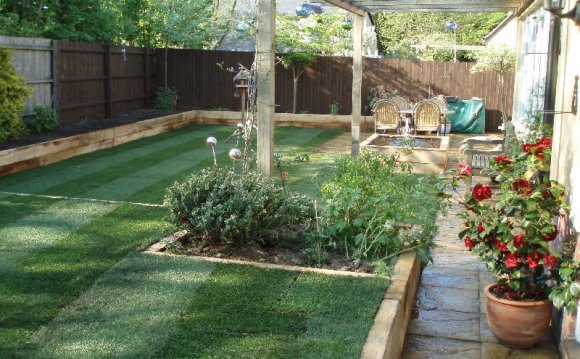
Apple trees usually grow up to 20 feet tall while dwarf varieties grow 6' - 8' tall. Many varieties are available, all producing beautiful early spring blossoms. Although some varieties are self-pollinating, many several other apple trees nearby to be able to produce fruit. Plant while dormant in full sun in slightly acidic soil. Most types of apple will fruit in three to five years. Ask at your local nursery to find the variety of apple tree best suited to your area.
Tree-form flowering almond is a variety of flowering almond that grows 12' - 15' tall and wide with a rounded crown. Pink or white flowers bloom in early spring before the leaves emerge. Plant in full sun or partial shade in moist, rich, acidic soil. If you want to prune for shaping, do so right after flowering. Some pruning will increase next season's flowers. (Zones 4 - 8.)
Chaste tree (Vitex agnus-castus) grows to 10' or 12' tall and produces lavender-purple flowers in early or mid-spring. The flowers give off a spicy aroma and the leaves smell faintly of sage. Shaping by pruning may be necessary. Grows best in well-drained soil. Flowers emerge from new shoots, so prune lightly at the end of winter. (Zones 7 - 9.)
Cherry
Some flowering cherry trees can grow to be quite tall, so check your local gardening center for a smaller variety. "Snow Fountain" grows up to 12' tall, while Sargent cherry grows 20' - 30' tall. Plant in full sun, in moist, well-drained soil. Weeping forms are available. (Zones 2 - 8, depending on the variety.)
Cherry Laurel
Cherry laurel (actually an evergreen cherry, Prunus laurocerasus) has evergreen, deep green leaves and fragrant white flowers. It grows 18' - 20' tall and wide. Flowers bloom mid spring and the tree produces dark berries. Plant in full sun in cool areas, or partial shade in warmer areas, in moist, well-drained soil. (Zones 7 - 8.)
Crabapple produces abundant, beautiful flowers in white, pink, or red, blooming mid-spring. These slow-growing trees rarely reach over 20' tall, while dwarf varieties grow between 8' and 15' tall. Crabapples are self-pollinating, so they will fruit even if you only plant one. Plant in full sun in well drained soil. Crabapples produce hard little fruits that some people find attractive but others may feel are a nuisance.
Crape myrtle (Lagerstroemia) is a tall, beautiful shrub that can stand in as a small tree, growing 15' - 20' tall. It blooms in mid- to late summer with long-lasting white, pink, red, or lavender blooms. The foliage turns yellow, orange, or red in fall. Attractive, exfoliating, patchy bark creates interest in winter. Prune away low-growing branches to create the look of a tree. (Zones 7 - 9.)
Kousa dogwood (Cornus kousa) is a small, cold-tolerant variety of dogwood that reaches 20' to 30' tall. Flowers range from creamy white to pink. Red fruits appear in fall.
Red osier dogwood (Cornus stolonifera or sericea) is a shrubby species that grows 7' - 9' tall. Red stems provide winter interest when young, but older branches fade to gray.
Franklin Tree
Franklin tree (Franklinia), named after Benjamin Franklin, should not be grown in its native home in the southeastern United States due to a root disease that makes the tree short-lived in that area. Franklin trees grow from 10' - 25' tall and 6' - 15' wide, producing large, fragrant white flowers. They prefer full sun and moist, well-drained, acidic soil. (Zones 5 - 8.)
Fringe Tree
Fringe tree (Chionanthus) grows from 12' - 20' tall with a broad, rounded form, and produces white, fragrant, lacy flowers in spring. Fruit on female trees attracts birds. Plant in full sun to partial shade in moist, well-drained soil. If you must prune to shape, do so right after flowering, as the blooms form on the older growth. Tolerant of wind and pollution. (Zones 4 - 9.)
"Winter King" green hawthorn (Crataegus viridis "Winter King") is an attractive deciduous tree with grayish green bark that may exfoliate on mature specimens. Winter King grows 15' - 30' feet tall with a similar spread. Aromatic white flowers appear in spring and red berries add interest in winter, though some people do not like their smell. Drought-tolerant and resistant to disease including verticillium. This variety is thornless despite its name. (Zones 4 - 7.)
(I planted my Winter King hawthorn after seeing in at a local park and reading about it online. People seemed to love this beautiful little tree and it has appeared a hot item with the landscape crowd. However, I later discovered that the presence of a nearby cedar or juniper can make for a nasty mess. Cedar - hawthorn rust needs both a cedar (or a juniper) and a hawthorn to complete its life cycle. This disease can devastate the hawthorn and make a mess of the juniper. As my juniper was older, and much beloved, I destroyed the hawthorn)















